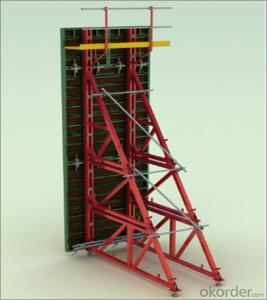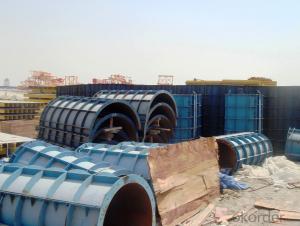Table formwork system for build
- Loading Port:
- China Main Port
- Payment Terms:
- TT OR LC
- Min Order Qty:
- -
- Supply Capability:
- -
OKorder Service Pledge
Quality Product, Order Online Tracking, Timely Delivery
OKorder Financial Service
Credit Rating, Credit Services, Credit Purchasing
You Might Also Like
Tabel Formwork:
Table formwork is the most typical application for slab, with timber beam, the slab formwork is
light weight, fast and economic in the construction.
Characteristics:
◆ Simple structure, easy assembly.
◆ Flexible structure, be adapted to different support system.
◆ High construction efficiency with special system tools.
1. Lifting fork for lifting the table formwork to upper floor.
2. Trolley for moving the table formwork on floor.
◆ Flexible application with stand alone props.
◆ Safer condition with handrails.
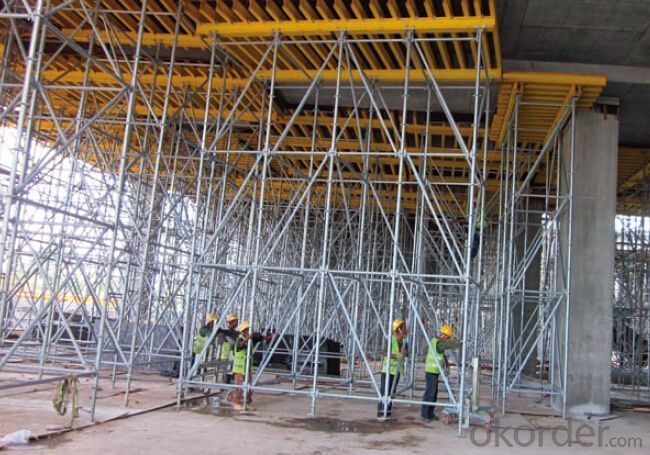
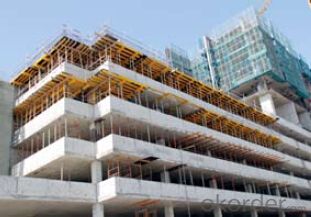
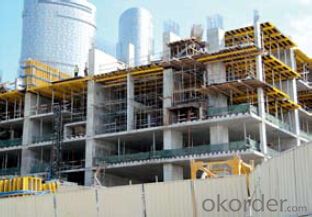
- Q:What are the different types of formwork systems that can be used in conjunction with steel frame formwork?
- There are various formwork systems available that can be used alongside steel frame formwork. These include: 1. Timber formwork: Timber formwork is widely used and involves using timber boards or plywood to create the formwork structure. It is versatile, cost-effective, and easy to work with, making it suitable for a range of concrete structures such as walls, columns, beams, and slabs. 2. Aluminum formwork: Aluminum formwork is a lightweight and durable system consisting of interconnected aluminum panels. It is known for its high strength-to-weight ratio, allowing for faster construction and reduced labor costs. This type of formwork is commonly used for repetitive structures like residential buildings and commercial complexes. 3. Plastic formwork: Plastic formwork is gaining popularity due to its versatility and ease of use. It is made of lightweight and durable plastic panels that can be easily assembled and disassembled. Plastic formwork is suitable for various concrete structures, including walls, columns, and slabs. It offers advantages such as lower labor costs, reduced waste, and improved construction speed. 4. Fiberglass formwork: Fiberglass formwork is lightweight and strong, made of fiberglass panels capable of withstanding high concrete pressures. It is suitable for different concrete structures, including walls, columns, beams, and slabs. Fiberglass formwork offers benefits such as easy handling, reduced labor costs, and improved construction speed. 5. Modular formwork: Modular formwork involves using standardized components to create different formwork configurations. It can be integrated with steel frame formwork by combining the steel frames with the modular components. Modular formwork is highly flexible and adjustable to meet various construction requirements. It is suitable for complex structures and can be reused, making it cost-effective. In summary, these formwork systems offer advantages such as versatility, cost-effectiveness, ease of use, and increased construction speed. The choice of formwork system will depend on factors like project requirements, budget, and timeline.
- Q:Can steel frame formwork be used for both conventional and lightweight concrete?
- Steel frame formwork is capable of being used for both conventional and lightweight concrete applications. Its versatility and durability make it a suitable choice for a wide variety of concrete projects. Whether it involves traditional aggregates and cement or lightweight aggregates like expanded clay, shale, or slate, steel frame formwork offers the necessary support and structure during the concrete pouring and curing stages. Its strength and stability enable it to handle the weight and pressure exerted by both conventional and lightweight concrete, ensuring that the desired shape and design of the concrete structure are successfully achieved.
- Q:What are the common transportation and logistics considerations for steel frame formwork systems?
- Some common transportation and logistics considerations for steel frame formwork systems include the weight and size of the components, the availability of suitable transportation vehicles, the need for proper handling and secure packaging to prevent damage during transit, and the requirement for efficient and organized storage at the construction site. Additionally, consideration may also be given to the availability of trained personnel to assemble and dismantle the formwork system, and the need for regular maintenance and inspection to ensure its safe and effective use.
- Q:How does steel frame formwork accommodate for different concrete pumping methods?
- Steel frame formwork proves to be a versatile and adaptable system capable of effectively accommodating various concrete pumping methods. Its design ensures robustness and stability, facilitating the efficient transfer of forces during the concrete pouring process. A significant advantage of steel frame formwork lies in its ability to withstand the high pressures generated by different concrete pumping methods. Truck-mounted boom pumps, stationary pumps, and line pumps all exert forces during the pumping process, which the steel frame formwork can handle without compromising its structural integrity. Moreover, customization and adjustment options are readily available with steel frame formwork to cater to different concrete pumping methods. The formwork panels can be designed with openings like holes or slots to accommodate pipes and hoses used in the pumping process. This feature ensures smooth and efficient pumping operations, preventing any blockages or hindrances. Additionally, the steel frame formwork system is easily disassembled and reassembled, making it suitable for diverse project requirements and changing pumping methods. This flexibility allows for effortless modifications and adjustments to the formwork system, ensuring it can adapt to any alterations in the concrete pumping method during the construction process. Overall, steel frame formwork proves to be a dependable and adaptable solution for accommodating various concrete pumping methods. Its robust nature, stability, and customization options make it the preferred choice in construction projects where concrete pumping is necessary.
- Q:How long does steel frame formwork typically last?
- Steel frame formwork typically lasts for several years, with proper maintenance and care. The exact lifespan can vary depending on factors such as usage, environmental conditions, and quality of materials.
- Q:How does steel frame formwork contribute to better concrete consolidation around reinforcement?
- There are several ways in which steel frame formwork contributes to improved concrete consolidation around reinforcement. Firstly, the rigid structure of the steel frames holds the formwork panels in place, preventing any deformation or bulging caused by the weight and pressure of the concrete. This ensures that the formwork maintains its correct dimensions and shape, resulting in even pouring of the concrete around the reinforcement. In addition, the support and stability provided by the steel frames prevent any movement or shifting of the formwork during the pouring and compaction of the concrete. This is particularly important when dealing with high-strength or large volumes of concrete, as any displacement of the formwork can lead to insufficient consolidation around the reinforcement. Furthermore, steel frame formwork often includes adjustable features like wedges or clamps, allowing for precise alignment and positioning of the formwork panels. This ensures proper centering of the reinforcement within the formwork, guaranteeing even distribution of the concrete around the reinforcement without any gaps or voids. Moreover, the smooth and flat surface provided by the steel frames facilitates the smooth flow and placement of the concrete. This minimizes the risk of air pockets or voids forming around the reinforcement, ensuring complete encapsulation and surrounding of the reinforcement by the concrete. Overall, steel frame formwork plays a critical role in ensuring improved concrete consolidation around reinforcement by offering a rigid, stable, and precisely aligned structure that supports the formwork panels and allows for the proper flow and placement of the concrete. This results in a stronger and more durable concrete structure with enhanced structural integrity.
- Q:What are the considerations for selecting the appropriate formwork for different concrete mixes?
- When selecting the appropriate formwork for different concrete mixes, there are several considerations that should be taken into account. These considerations include the type of concrete mix, the desired finish of the concrete surface, the required strength of the structure, the complexity of the formwork design, and the availability and cost of the formwork materials. First and foremost, the type of concrete mix being used is an important factor. Different mixes have varying properties, such as workability, setting time, and shrinkage. For example, if a concrete mix has a high workability, it may require a more rigid and stable formwork system to prevent bulging or deformation during pouring and curing. On the other hand, a mix with low workability may require a more flexible formwork system that can accommodate the limited flow of the concrete. The desired finish of the concrete surface is another consideration. If a smooth and aesthetically pleasing finish is required, the formwork should be able to provide a tight and smooth surface without any deformities or marks. This may require using formwork materials that are resistant to moisture absorption or have a smooth surface finish themselves. Alternatively, if the finish is not as critical, less expensive and simpler formwork options may be suitable. The required strength of the structure also plays a role in formwork selection. If the structure needs to withstand high loads or have a long service life, the formwork should be able to withstand the pressure exerted by the concrete during pouring and curing. This may involve using stronger and more durable formwork materials, such as steel or engineered wood, as opposed to traditional timber formwork. The complexity of the formwork design is another consideration. If the structure has intricate shapes or unique geometries, the formwork system needs to be able to accommodate these complexities. This may require using adjustable formwork systems, modular formwork components, or custom-made formwork. It is important to select a formwork system that can be easily assembled and disassembled to ensure efficient construction. Lastly, the availability and cost of the formwork materials should be taken into account. Some formwork materials may be readily available in certain regions, while others may need to be imported or specially ordered. Additionally, the cost of the formwork materials can vary significantly, depending on the type and quality. It is essential to consider the budget constraints and the overall cost-effectiveness of the formwork system. Overall, selecting the appropriate formwork for different concrete mixes requires a careful evaluation of factors such as the type of mix, desired finish, required strength, complexity of design, and cost considerations. By considering these factors, one can choose the most suitable formwork system that ensures efficient construction and meets the specific requirements of the project.
- Q:Does steel frame formwork require any special maintenance?
- Special maintenance is required for steel frame formwork. Firstly, it is necessary to clean the formwork thoroughly after each use to eliminate any concrete residue or debris that may have accumulated. This can be achieved by utilizing high-pressure water or wire brushes. In addition, any rust or corrosion on the steel frame should be addressed and removed to prevent further harm. Regular inspection of the formwork is also crucial to identify any signs of wear and tear, such as cracks, dents, or bent components. Any damaged parts should be promptly repaired or replaced to guarantee the formwork's structural integrity and safety. Moreover, proper storage plays a vital role in maintaining the quality and durability of steel frame formwork. The formwork should be stored in a dry and well-ventilated area to prevent moisture buildup and corrosion. Applying a rust-resistant paint or protective coating to the steel frame is also recommended to provide an extra layer of defense against environmental factors. By consistently maintaining and taking care of steel frame formwork, not only will its lifespan be extended, but its reliability and safety during construction projects will also be ensured.
- Q:Can steel frame formwork be used for both indoor and outdoor construction?
- Yes, steel frame formwork can be used for both indoor and outdoor construction. Steel frame formwork is a versatile and durable option that can withstand the various conditions and elements present in both indoor and outdoor environments. The steel frame provides stability and strength, making it suitable for use in different construction projects. Additionally, steel frame formwork offers advantages such as easy assembly, reusability, and the ability to create complex shapes and structures. Overall, steel frame formwork is a reliable choice that can be used in a wide range of construction settings.
- Q:Can steel frame formwork be used in projects with limited project duration or tight schedules?
- Yes, steel frame formwork can be used in projects with limited project duration or tight schedules. Steel frame formwork offers several advantages that make it suitable for fast-paced construction projects. Firstly, steel frame formwork is lightweight and easy to handle, making it quick to assemble and dismantle. This can help save time during the construction process. Additionally, steel frame formwork is highly durable and can withstand multiple uses, which is beneficial for projects with tight schedules as it allows for faster concrete pouring and formwork re-use. Furthermore, steel frame formwork is adjustable and versatile, allowing for flexibility in design and layout changes, which can be crucial in projects with limited project duration. Overall, the use of steel frame formwork can contribute to increased productivity, reduced construction time, and improved efficiency in projects with limited project duration or tight schedules.
1. Manufacturer Overview |
|
|---|---|
| Location | |
| Year Established | |
| Annual Output Value | |
| Main Markets | |
| Company Certifications | |
2. Manufacturer Certificates |
|
|---|---|
| a) Certification Name | |
| Range | |
| Reference | |
| Validity Period | |
3. Manufacturer Capability |
|
|---|---|
| a)Trade Capacity | |
| Nearest Port | |
| Export Percentage | |
| No.of Employees in Trade Department | |
| Language Spoken: | |
| b)Factory Information | |
| Factory Size: | |
| No. of Production Lines | |
| Contract Manufacturing | |
| Product Price Range | |
Send your message to us
Table formwork system for build
- Loading Port:
- China Main Port
- Payment Terms:
- TT OR LC
- Min Order Qty:
- -
- Supply Capability:
- -
OKorder Service Pledge
Quality Product, Order Online Tracking, Timely Delivery
OKorder Financial Service
Credit Rating, Credit Services, Credit Purchasing
Similar products
New products
Hot products
Related keywords



















